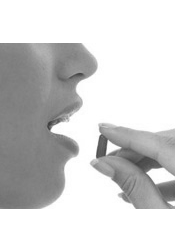Kalydeco® tablet
This product is manufactured by Vertex Pharmaceuticals using the ingredient ivacaftor.
This product is taken orally.

play
orally
Why is it prescribed?
Ivacaftor is used for the treatment of cystic fibrosis (CF):
- in children age 2 months and older who have certain mutations in the cystic fibrosis transmembrane conductance regulator (CFTR) gene
Kalydeco® should always be taken with a fat-containing food to ensure you get the proper amount in your system. Each dose should be taken just before or just after fat-containing food.
If you miss a dose of Kalydeco® and it is within 6 hours of when you usually take it, take your dose as prescribed with fat-containing food as soon as possible. If you miss a dose and it is more than 6 hours after the time you usually take it, skip that dose only and take the next dose when you usually take it. Do not take 2 doses at the same time to make up for your missed dose.
Instructions for use:
Kalydeco® tablets:
- Each box contains 4 individual blister cards.
- There are 7 days of tablets for each blister card. Each blister card contains 14 tablets - 7 morning doses and 7 evening doses.
- You may cut along the dotted line to separate your doses from the blister card.
- Morning Dose: unpeel the paper backing from a blister card. Do not push the tablet through the paper backing because the tablets could break. Remove one tablet and swallow it whole with food that contains fat.
- Evening Dose: 12 hours after your first dose, unpeel the paper backing from another blister card to remove one tablet and swallow it whole with food that contains fat.
- Do not crush or chew the tablets
Store at 20-25 degrees C.
Alternatives
Other products that have the same ingredient as Kalydeco® tablet are •Kalydeco® granules •Orkambi® •Symdeko™ tablet •Trikafta® granules •Trikafta® tablet •
See other products used in the treatment of •cystic fibrosis •
Recommended dose for 6 months of age ≥25 kg and older - 1 tablet (150mg) twice daily
For dosage in children 2 mos - 6 mos <25 kg, see Kalydeco® granules.
Various mutations of the cystic fibrosis gene block the "gates" that allow the flow of salt across the cell membranes. This causes mucus to become thick and clog the lungs. Ivacaftor is a "cystic fibrosis transmembrane conductance regulator (CFTC) potentiator". The CFTR protein is a channel at the surface of the cells that allows the movement of particles such as chloride in and out of the cell, contributing to salt and water balance. Ivacaftor helps this CFTR protein channel or "open the gates" more often allowing more salt to pass through. The thick mucus is reduced and cystic fibrosis symptoms lessen.
Contact your doctor if any of these side effects persists or are bothersome:
• Diarrhea
• Nausea
• Stomach (abdominal) pain
• Common cold
• Runny nose
• Upper respiratory tract infection
• Changes in the type of bacteria in your sputum
• Headache
• Dizziness
• Nasal congestion
• Sinus congestion
• Sore throat
• Rash
• Joint pain
Use with caution if you:
- have kidney or liver problems
- have cataracts
Possible drug interactions:
- ketoconazole, itraconazole, posaconazole, voriconazole, fluconazole
- some antibiotics such as clarithromycin, erythromycin, rifampin, rifabutin
- phenobarbital, carbamazepine, phenytoin
- midazolam, alprazolam, diazepam, triazolam
- digoxin
- cyclosporine, tacrolimus
- warfarin
- St. John’s wort
Use in pregnancy and breastfeeding. Little is known about the safety of this medication when used in pregnancy and breastfeeding. Consult your doctor or pharmacist before use.
